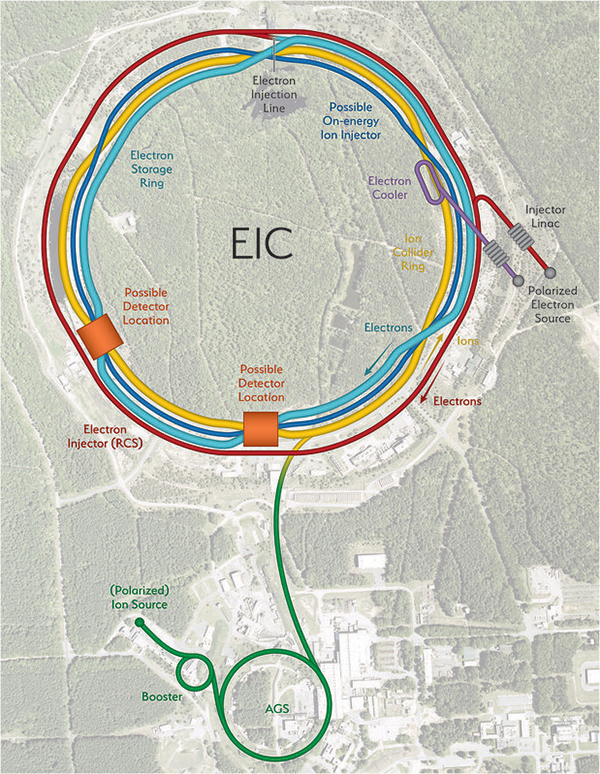Imaging quarks and gluons
The Electron-Ion Collider (EIC) in the USA is to benefit from UK know-how. The EIC will be built at Brookhaven National Laboratory and will provide answers to some of the most fundamental questions in science on the nature of matter.

A schematic of an Electron-Ion Collider, a new nuclear physics research facility for probing the inner structure of the building blocks of matter. The EIC will add a new electron source and electron accelerator and storage rings inside the tunnel currently housing the Relativistic Heavy Ion Collider (RHIC), background photo, and will reuse key components of that facility.
© Brookhaven National LaboratoryWith £3 million funding through the Science and Technology Facilities Council (STFC), nuclear and particle physicists in the UK will be leading preliminary work to help design the detectors at the new facility.
This new facility will allow imaging of the quarks and gluons that are found inside protons and atomic nuclei. Scientists will be able to study not only how they are distributed but also how they move and interact with one another.
The work could change our understanding of the strong interaction, one of the fundamental forces of nature. This force governs the behaviour of hadrons, the family of subatomic particles that includes protons and neutrons, and is behind more than 99% of the visible mass of the universe. Researchers could discover how the strong interaction works as a glue to hold matter together.
The EIC is similar to a high-energy electron microscope but with the ability to explore the internal structure of protons and nuclei. Detectors must be able to pick up the scattered electrons and any particles produced in each collision with high precision so that scientists can construct an accurate picture of what is found inside.
Professor Peter Jones from the University of Birmingham says, ‘The EIC promises to answer some longstanding science questions about the origin of mass and the spin of the nucleon. It also has the potential to shine a light on what happens when atomic nuclei fill up with gluons.’
There are three work packages associated with this project -
- Monolithic Active Pixel Sensor (MAPS) technology
Development of tracking detectors based on state-of-the art MAPS technology. These are exceptionally thin silicon detectors with high position resolution and covering a large area to act like a powerful digital camera, capturing the products of the collisions in exceptional detail.
This work package is led by University of Birmingham and involves -the universities of Brunel, Lancaster and Liverpool, and STFC’s Particle Physics and Technology Departments at the Rutherford Appleton Laboratory and the Nuclear Physics Group at Daresbury Laboratory. - Silicon-based detector arrays
Development of smaller silicon-based detector arrays for particle tracking in challenging regions of very high intensity, requiring excellent rate capability and timing resolution.
This work package is led by the University of Glasgow, working closely with members of the CERN, Timepix4 collaboration and STFC’s Nuclear Physics Group at Daresbury Laboratory. - Precision nucleon polarimetry
Technology evaluation and advanced simulation developments for precision nucleon polarimetry. This work package is led by the University of York.
It is expected that construction of the accelerator and its detectors will commence around 2023 to 2024, once the technical design is complete.
The first-year funding was approved under the UK Research and Innovation infrastructure fund. The funding does not equate to a full commitment to the EIC.







